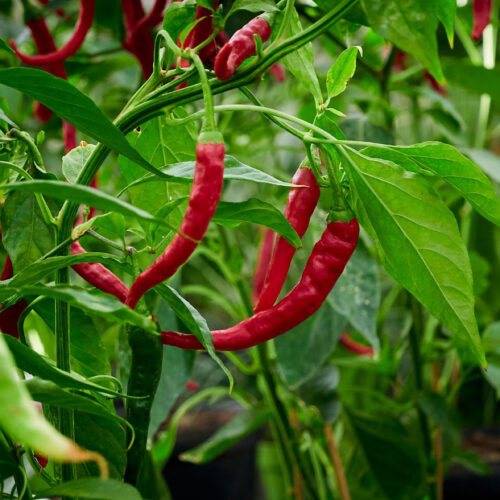Planting an Italian kitchen garden for all your Italian cooking needs? Be sure to include some peppers. You will find mostly sweet pepper varieties in the Italian garden, with a few that have a mild spice. Find out more about the best types of Italian peppers to grow, their flavor, growing tips, and classic recipe ideas

Jump to: Different Types Italian Peppers | Growing Tips | Italian Recipe Ideas
This post may contain affiliate links. As an Amazon Associate, I also earn from qualifying purchases. You can read our disclosure information here–
The Importance of Peppers in Italian Kitchen Gardens
Like Italian tomatoes, peppers haven’t been around in Italy for all that long. They first reached the region after being brought back from the recently discovered Americas, but like tomatoes, they were initially considered decorations rather than food.
Did you know? Once the Italians figured out that peppers were in fact delicious, which we can deduce from old cookbooks that happened around the 1600s, they quickly became a staple vegetable (even though they were sometimes still seen as a “vulgar” choice).
Nowadays, we can find sweet peppers in nearly all of Italy’s local cuisines.
Types of Peppers for the Italian Kitchen Garden
The Italians have been highly productive over the years regarding peppers. They’ve developed loads of different local pepper varieties used in all sorts of traditional dishes.
If you’re planning your own Italian kitchen garden, be sure to include one or two of the peperoni (yes, spelled with one P!) discussed below. I promise you won’t regret it.
Look for peppers that come in red (rosso), yellow (giallo) and green (verde).
Here are the Italian varieties that are readily found in the U.S. or popular seed catalogs:
Quadrato D’Asti: Meaning square, these Italian heirlooms are huge, blocky, thick-walled Bell Peppers with a rich sweet taste that is enhanced when roasted, grilled, or baked with a savory stuffing. Ripen from green to beautiful candy apple-red; Up to 6″ long and 4½” wide.

Lunga Sigaretta: Long and skinny, these look like they would be quite spicy, but they are actually sweet with a very mild spice level. Traditionally used for pickling, referred to as sott’aceto. Difficult to find, but can be purchased from Magic Garden.

Peperoni di Senise: A gourmet pepper from Basilicata region of Italy. It is named after the village Senise and cannot be sold unless it comes from its area of origin, similar to the fact that Hatch chile peppers must come from New Mexico. These peppers have a very mild heat and rival the Padron as a frying pepper. Easy to grow and very productive!

Carmen Corno di Toro: its name means bull horn, and this pointed pepper is notably sweet (especially when fully red-ripe). Begins green, then deepens to a beautiful carmine at maturity. Excellent roasted, grilled, and in salads. One of the most popular Italian sweet pepper varieties to grow at home.

Marconi Red Pepper: elongated, deep red, and very sweet. Fruits are great for frying, stuffing, or slicing into rings for salads.

Jimmy Nardello: heirloom variety that was brought over to the States from Italy in 1887. Pointed, thin, and a little wrinkled—plus delightfully sweet. Very prolific

Piccante Calabrese: the Italian name translates to the “spicy pepper of Calabria”; round and about the size of a large cherry; traditionally stuffed with chunks of tuna and kept in jars of olive oil; can also be pickled in a vinegar brine.

Sweet Pepper Growing Tips
- Starting: You can sow peppers indoors around 8 weeks before the last expected frost date. Harden off and transplant outside once the soil has reached 60 °F.
- Container growing: Sweet peppers can be grown in surprisingly small containers. A 2 or 3-gallon pot should be enough to sustain most types. Water consistently, as potted plants dry out quickly if growing in terra cotta or fabric pots.
- Support: Varieties with large fruits may benefit from staking to prevent them from falling over.
- Harvest: Pick whenever you want. If you like green peppers, you can pick them before they reach their final red, yellow, orange, or chocolate brown color. Just know that the longer they stay on the vine and turn their final color, the sweeter they will be. Full ripening usually takes 80-90 days.
- Troubleshooting Peppers can suffer from blossom end rot due to calcium shortages. Pests can be combated using insecticidal soap and neem oil.
Cooking with Italian Peppers
Here are some traditional Italian recipes that feature sweet peppers as their star ingredient.
- Peperonata: one of the easiest and most delicious dishes you can make with your Italian peppers. All you need to make peperonata is plenty of time time to cook the peppers down into a velvety sweet saucy texture, using olive oil, onion, and garlic to elevate their flavor.
- Insalata rinforzo: a typical Neapolitan Christmas dish, the “strengthening” salad consists of cauliflower, anchovies, olives, capers, and delicious pickled Papacella Napoletana peppers.
- Papaccelle ‘mbuttunate: also made with the amazing papacella, ‘mbuttunate refers to a pepper stuffed with anchovies, capers, breadcrumbs, garlic, and parsley. Umami explosion!
- Risotto ai peperoni: this risotto is cooked in a creamy sweet pepper purée.
- Caponata: although this is mainly considered an eggplant recipe, it showcases sweet peppers as well. Considered Italy’s answer to French tian. Similar to this ratatouille recipe.

If you like my articles about cooking and gardening, subscribe to my weekly newsletter, where I share free recipes and gardening tutorials.


Leave a comment